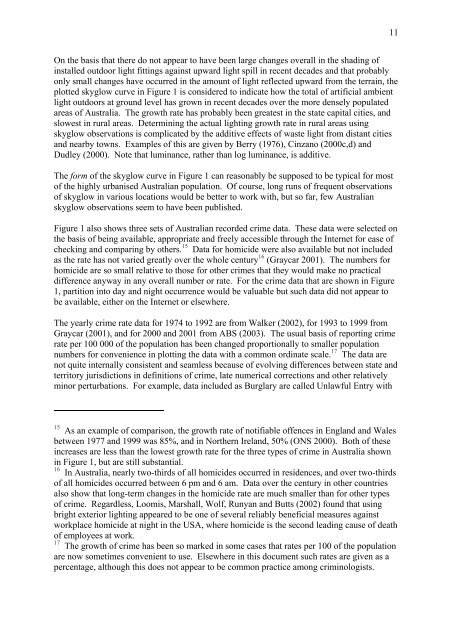Outdoor Lighting and Crime - Amper
Outdoor Lighting and Crime - Amper
Outdoor Lighting and Crime - Amper
Create successful ePaper yourself
Turn your PDF publications into a flip-book with our unique Google optimized e-Paper software.
On the basis that there do not appear to have been large changes overall in the shading of<br />
installed outdoor light fittings against upward light spill in recent decades <strong>and</strong> that probably<br />
only small changes have occurred in the amount of light reflected upward from the terrain, the<br />
plotted skyglow curve in Figure 1 is considered to indicate how the total of artificial ambient<br />
light outdoors at ground level has grown in recent decades over the more densely populated<br />
areas of Australia. The growth rate has probably been greatest in the state capital cities, <strong>and</strong><br />
slowest in rural areas. Determining the actual lighting growth rate in rural areas using<br />
skyglow observations is complicated by the additive effects of waste light from distant cities<br />
<strong>and</strong> nearby towns. Examples of this are given by Berry (1976), Cinzano (2000c,d) <strong>and</strong><br />
Dudley (2000). Note that luminance, rather than log luminance, is additive.<br />
The form of the skyglow curve in Figure 1 can reasonably be supposed to be typical for most<br />
of the highly urbanised Australian population. Of course, long runs of frequent observations<br />
of skyglow in various locations would be better to work with, but so far, few Australian<br />
skyglow observations seem to have been published.<br />
Figure 1 also shows three sets of Australian recorded crime data. These data were selected on<br />
the basis of being available, appropriate <strong>and</strong> freely accessible through the Internet for ease of<br />
checking <strong>and</strong> comparing by others. 15 Data for homicide were also available but not included<br />
as the rate has not varied greatly over the whole century 16 (Graycar 2001). The numbers for<br />
homicide are so small relative to those for other crimes that they would make no practical<br />
difference anyway in any overall number or rate. For the crime data that are shown in Figure<br />
1, partition into day <strong>and</strong> night occurrence would be valuable but such data did not appear to<br />
be available, either on the Internet or elsewhere.<br />
The yearly crime rate data for 1974 to 1992 are from Walker (2002), for 1993 to 1999 from<br />
Graycar (2001), <strong>and</strong> for 2000 <strong>and</strong> 2001 from ABS (2003). The usual basis of reporting crime<br />
rate per 100 000 of the population has been changed proportionally to smaller population<br />
numbers for convenience in plotting the data with a common ordinate scale. 17 The data are<br />
not quite internally consistent <strong>and</strong> seamless because of evolving differences between state <strong>and</strong><br />
territory jurisdictions in definitions of crime, late numerical corrections <strong>and</strong> other relatively<br />
minor perturbations. For example, data included as Burglary are called Unlawful Entry with<br />
15 As an example of comparison, the growth rate of notifiable offences in Engl<strong>and</strong> <strong>and</strong> Wales<br />
between 1977 <strong>and</strong> 1999 was 85%, <strong>and</strong> in Northern Irel<strong>and</strong>, 50% (ONS 2000). Both of these<br />
increases are less than the lowest growth rate for the three types of crime in Australia shown<br />
in Figure 1, but are still substantial.<br />
16 In Australia, nearly two-thirds of all homicides occurred in residences, <strong>and</strong> over two-thirds<br />
of all homicides occurred between 6 pm <strong>and</strong> 6 am. Data over the century in other countries<br />
also show that long-term changes in the homicide rate are much smaller than for other types<br />
of crime. Regardless, Loomis, Marshall, Wolf, Runyan <strong>and</strong> Butts (2002) found that using<br />
bright exterior lighting appeared to be one of several reliably beneficial measures against<br />
workplace homicide at night in the USA, where homicide is the second leading cause of death<br />
of employees at work.<br />
17 The growth of crime has been so marked in some cases that rates per 100 of the population<br />
are now sometimes convenient to use. Elsewhere in this document such rates are given as a<br />
percentage, although this does not appear to be common practice among criminologists.<br />
11
















